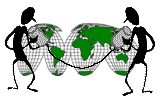“Six
Show-Stopping Mistakes You Can Easily Avoid When Developing Content
for Global Consumption”
 Local
translation expert Amy Kardel
(right), principal of Global
Accent Translation Services, a San Luis Obispo-based agency, riveted
our attention on the ABCs of translating content for international
consumers at this lively meeting. Her entertaining, rapid-fire style
left few topics uncovered as she fielded dozens of questions during
the highly interactive session. Local
translation expert Amy Kardel
(right), principal of Global
Accent Translation Services, a San Luis Obispo-based agency, riveted
our attention on the ABCs of translating content for international
consumers at this lively meeting. Her entertaining, rapid-fire style
left few topics uncovered as she fielded dozens of questions during
the highly interactive session.
Amy provided
definitions of confusing translation terminology,
a description of the fascinating work her company does, and tips on
how to stay out of trouble when preparing to have content translated.
Did
you know . . .
- Many
requests are for English-to-English translations! Similar to other
technical communicators, translators are often asked to take dense prose
and convert it into eighth grade, understandable
 language
as part of a
“low-literacy”
English translation. language
as part of a
“low-literacy”
English translation.
- There
are very few trilingual translators. To be highly proficient in
only two languages is quite a feat. Even bilingual translators typically
translate from a “B” language (not their strongest) to an
“A” language (their strongest). However, many can interpret
from an “A” to a “B” language.
- Translation
is a huge industry, with about $13 billion spent annually on information
conversion. This figure may double by 2007. The most commonly translated
materials include business information, software interfaces, Web content,
and presentations.
- To
stay current in a language, translators typically live in a country
that speaks their “A” language — they must either use
it constantly or lose it!
- Estimating
a translation job entails a complex process,
as many factors must be taken into account. For example, how soon is
the translation needed? In what context? What languages are involved?
How much content redundancy exists? Computer-assisted translation (CAT)
can offer powerful assistance by electronically parsing samples of the
material to create a lexicon of reusable information chunks, which can
result in more accurate estimates and lower translation costs. However,
the real work still must be performed by a human being —
at the rate of six to eight pages per day and $.25 a word. The mantra
to repeat when first developing the content is “cut the fat”!
Alphabet
soup! Key terms demystified . . .
-
Globalization
(sometimes abbreviated “G11n”) refers to getting an entire
enterprise ready to do business with foreign audiences. All internal
and external business functions must be prepared to respond to phone
calls, correspondence, customer support requests, and other types
of contacts, whether or not translation occurs.
- Internationalization
(sometimes abbreviated “I18n”) pertains to planning how the
content, format, and layout should be modified to accommodate translation
and also convey sensitivity and respect for other cultures. Considerations
include the inevitable 25%-50% expansion of textual content when translating
from English to the “FIGS” languages (French, Italian, German,
and Spanish), for example; adjusting the widths of columns, field labels,
and templates accordingly; and carefully evaluating the use of images,
phrases, and humor to avoid violating any cultural sensitivities.
- Localization
(sometimes abbreviated “L10n”) involves the actual translation
required to make a product understandable in a particular language and
culture. Even within English, significant orthographic variations exist.
Localization also entails the conversion of currencies, dates, times,
symbols, units of measurement, forms of transportation, and even common
sounds! A car horn in the U.S. honks very differently from the corresponding
bleeps and warbles in Europe, for example.
And
above all, avoid the six deadly translation sins . . .
1.
Don't underestimate the amount of time it will take to translate
your material. Expecting too much too fast can compromise the
quality and also increase the cost.
2.
Make sure communication channels are wide open. If translators
have unanswered questions or lack access to the most current project
materials, it can result in delays and misinterpretations at a critical
juncture in your project.
Develop a responsive query process for translators to use.
3.
Don't embed textual information in graphics. It will all need
to be translated! And, since the text will most likely expand, the
graphics would have to be redesigned. Better to use a more generic
image with outside “callouts” — text boxes that contain
editable information — to explain specific areas of the graphics.
4.
Design user interfaces with longer labels in mind. The expansion
of words and phrases in various languages requires extra planning
in the area of software interface design.
5.
Be consistent with phrases in the original material. Consistency
(even if it seems boring) cuts down translation costs considerably,
since accurate, speedy translation depends on the ability to reuse
chunks of information whenever possible.
6.
Avoid cultural and technical faux pas! A cultural embarrassment
is one that involves using images, symbols, or phrases that have derogatory,
insulting, or off-color meanings in other cultures. A technical embarrassment
is one that involves a failure to convert measurements from one context
to another, for example, which can result in dangerous or expensive
project mistakes.
Photography
by Mary Meyer.
|